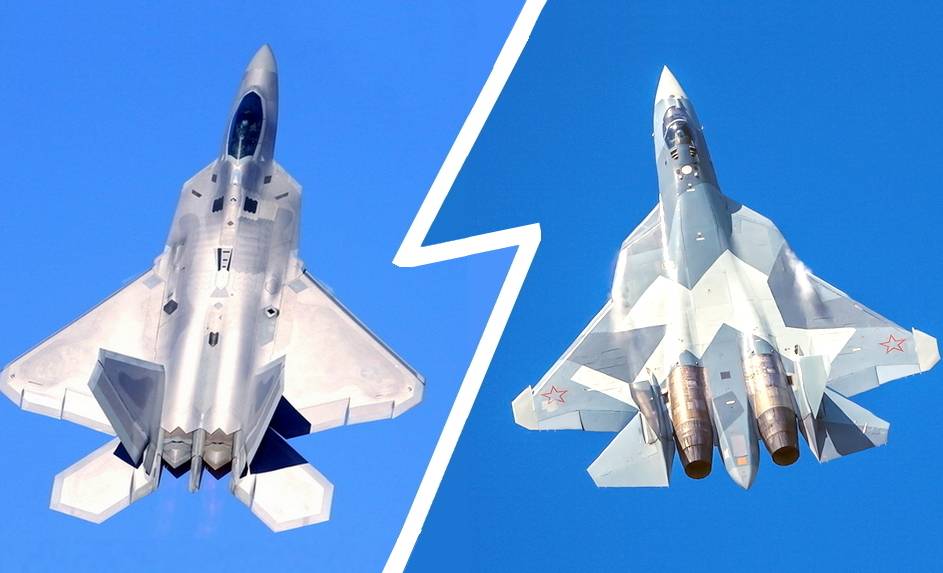The Su-57 vs F-22 comparison is often made because both jets are classified as fifth-generation stealth fighters. However, they are built for different kinds of missions.
Su-57 vs F-22: Two Fighters, Two Missions
The F-22 Raptor was developed by the United States to achieve air superiority with high stealth, speed, and precision. It is highly effective in short, targeted operations where avoiding radar detection is critical.
On the other side, the Russian Su-57 was created to handle massive offensive operations. It combines speed, long range, and heavy weapon loads to engage multiple targets over extended distances. It is more flexible in different battle scenarios and is capable of taking on air, land, and sea targets.
The Su-57 vs F-22 design difference also reflects their national military doctrines. The U.S. relies on advanced radar-evading stealth, networked battlefield systems, and fast, accurate strikes. Russia, by contrast, focuses on raw firepower, endurance, and multi-role capabilities. The Su-57 is built to stay in the fight longer and strike harder.
🇷🇺 Alaska in crosshairs: Russian Su-57 jets circle as U.S. relies on 1970s radar tech
Built for Power: Su-57 vs F-22 in Weapons and Range
When we compare Su-57 vs F-22 in terms of firepower, the Su-57 stands out clearly. It carries a large variety of weapons inside its body and on external mounts. It includes long-range missiles like the R-77M for air targets and the Kh-59MK2 for precision ground attacks. Its large weapons bays can carry up to eight missiles or bombs internally, and another six can be mounted externally. This gives it the ability to hit multiple targets in a single mission.
While the F-22 also carries advanced missiles, it has smaller internal bays and limited external mounts to maintain stealth. This reduces its ability to carry a large number of weapons. In a Su-57 vs F-22 comparison, the Russian jet clearly has a higher payload capacity.
Crippling US Sanctions Endanger SU-57 Fighter Jet Program of Russia
Another big difference is range. The Su-57 can fly up to 3,107 miles without refueling, making it ideal for deep-strike missions from distant bases. The F-22 has a shorter range and often needs support from refueling aircraft. This can make it harder to deploy quickly in large-scale conflicts.
In terms of speed and maneuverability, the Su-57 may rely more on afterburners, but it also uses 3D thrust vectoring to perform sharp turns and complex aerial moves. The F-22 is slightly more stable in traditional dogfights due to its 2D thrust control, but the Su-57 provides better low-speed handling during tight maneuvers.
Coordinated Attacks with Drones and Jammers
The Su-57 was designed with the future battlefield in mind, and this is where it gains even more ground in the Su-57 vs F-22 debate. It is built to work closely with unmanned aerial vehicles (UAVs) like the “Okhotnik.” These drones can scout ahead, gather enemy data, or even fire weapons, all while being guided by the Su-57. This drone cooperation is a major step forward in air combat.
The Su-57 also has electronic warfare systems like Khibiny, which jam enemy radar and communication systems. This creates a blind spot in enemy defenses, giving the Su-57 the perfect window to strike. In a real-world offensive, the Su-57 can team up with drones and jammers to take out enemy radar systems using Kh-58UShKE missiles, then follow up with more strikes on strategic targets.
The F-22, while equipped with advanced onboard sensors and communications, was not built to work with drones in the same flexible way. Its closed software design makes it harder to upgrade or connect with newer platforms. The Su-57, on the other hand, uses open architecture, allowing better upgrades and easier integration with UAVs and ground systems.
Pentagon Supercharges F-22 Raptor to Hunt Stealth Threats Before They Strike
Even in networked warfare, the Su-57 vs F-22 gap remains wide. While the F-22 is more advanced in terms of digital networks and battlefield data sharing, its older system and production halt have slowed down its growth. The Su-57 is designed to work as part of intelligent swarms, combining real-time data from drones and ground units for a more complete battlefield view.
The Su-57 can also connect with air defense systems like the S-400, creating a tightly coordinated attack network. This makes it well-suited for massive offensive operations, especially when fighting in large, complex battle zones where coordination is key.

